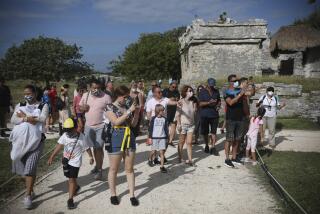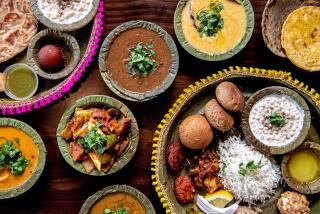Soaking up the local color at Holi in India
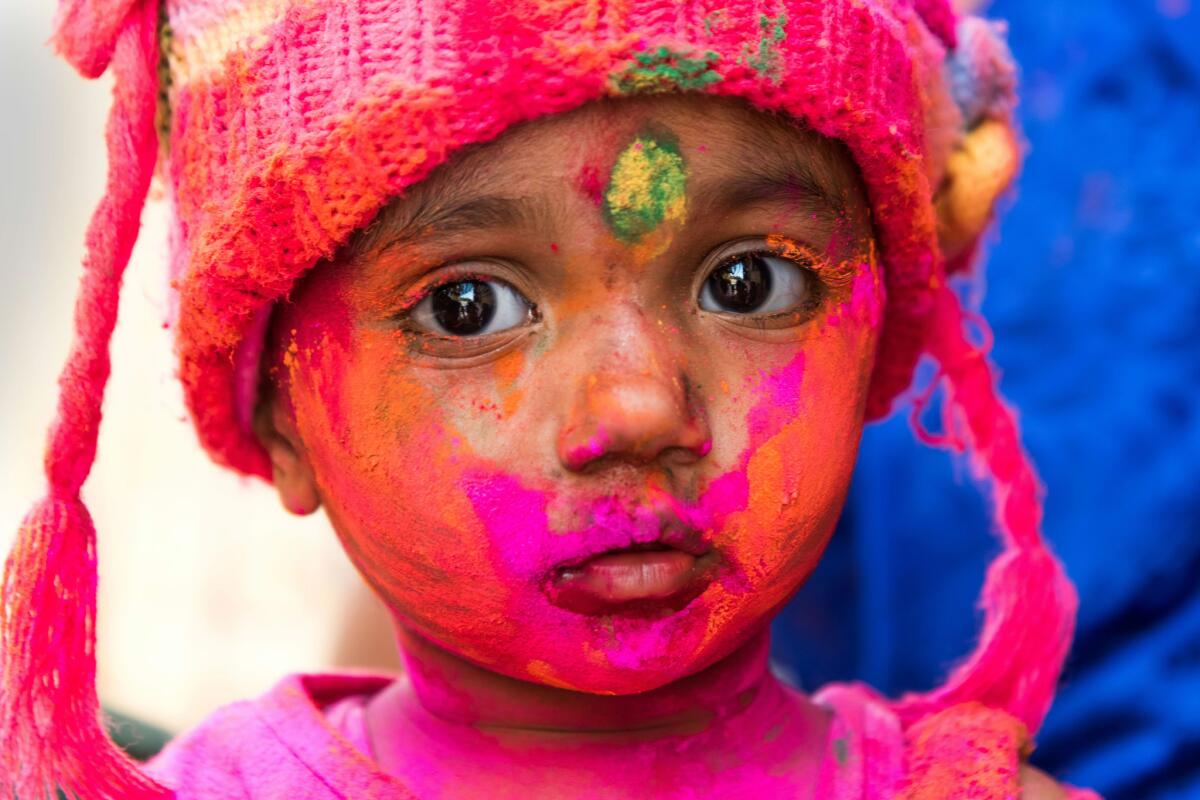
Reporting from Jaisalmer, India — There’s something oddly alluring about having strangers in a remote part of India walk up to you and smear your face ever so delicately with powdered paint. Not so much when they throw it at you.
This happens throughout India during Holi, the Hindu celebration also known as the Festival of Colors, which begins the evening of March 12 and continues on March 13.
I became a human color wheel at last year’s event while exploring the 800-year-old town of Jaisalmer, a life-size sandcastle rising out of the Thar Desert.
The Golden City, in the state of Rajasthan about 100 miles from the Pakistan border, is known for its hilltop fort featuring an 11-story palace and intricately carved Jain temples, some of which date to the 12th century.
My husband, Chris, and I were in Delhi for his nephew’s marriage to an Indian American woman. After the “abbreviated” four-day wedding, we embarked on an adventure — if you call being chauffeured in an SUV an adventure.
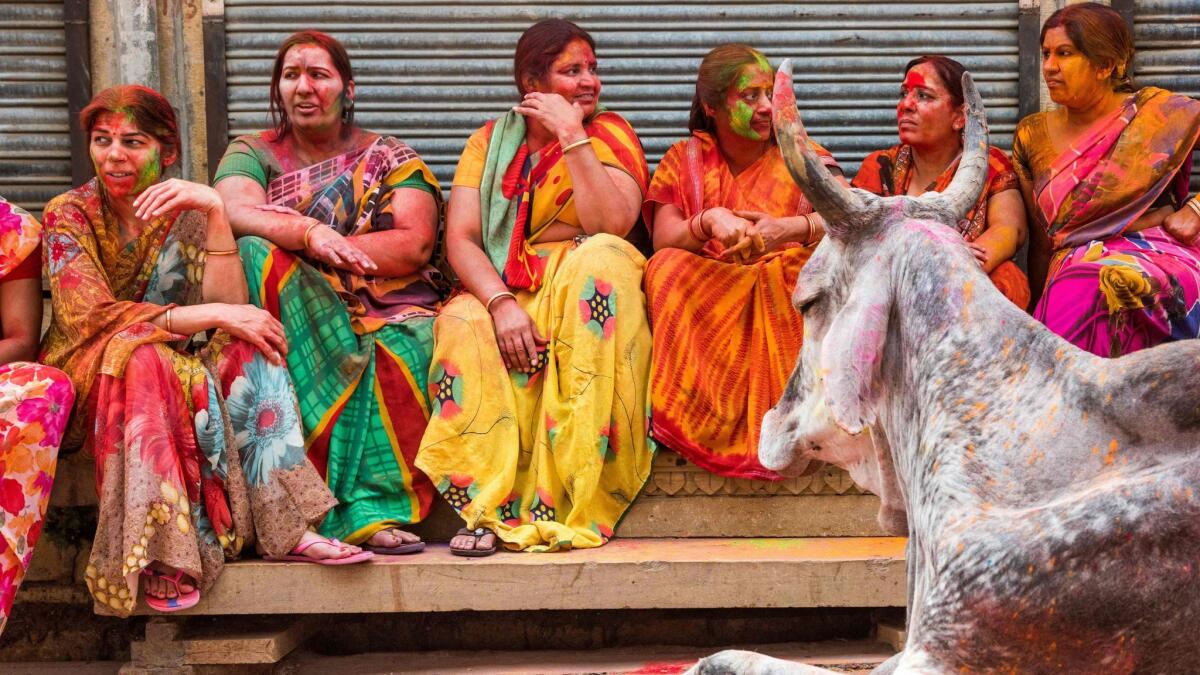
For Westerners, even those like me with experience navigating the unapologetic byways of Boston, renting a car in India is not an option unless you have a death wish.
After our flight from Delhi to Jodhpur, we could ogle a constantly shifting array of sights during the eight-hour drive to Jaisalmer. These included wandering cows and camel herds, mini-mountains of psychedelic textiles, and an unending parade of ornately decorated buses that managed — always at the last minute — to swerve out of our way.
In the U.S., you can dive deep into color festivals year-round »
We chose Jaisalmer, a pint-size town of 80,000, partly to avoid getting caught in a maelstrom of pigment-possessed party-goers common in bigger cities.
But we were also enchanted by its history. Jaisalmer was founded in 1156 by Rawal Jaisal, a descendant of a famous prince, and is dominated by one of the world’s few remaining inhabited forts, now part of a UNESCO World Heritage site.
After a couple of days wandering amid the havelis, beautifully sculpted sandstone mansions, some as many as 300 years old, it was time to buy light-colored clothing we wouldn’t mind leaving behind.
Happy Holi
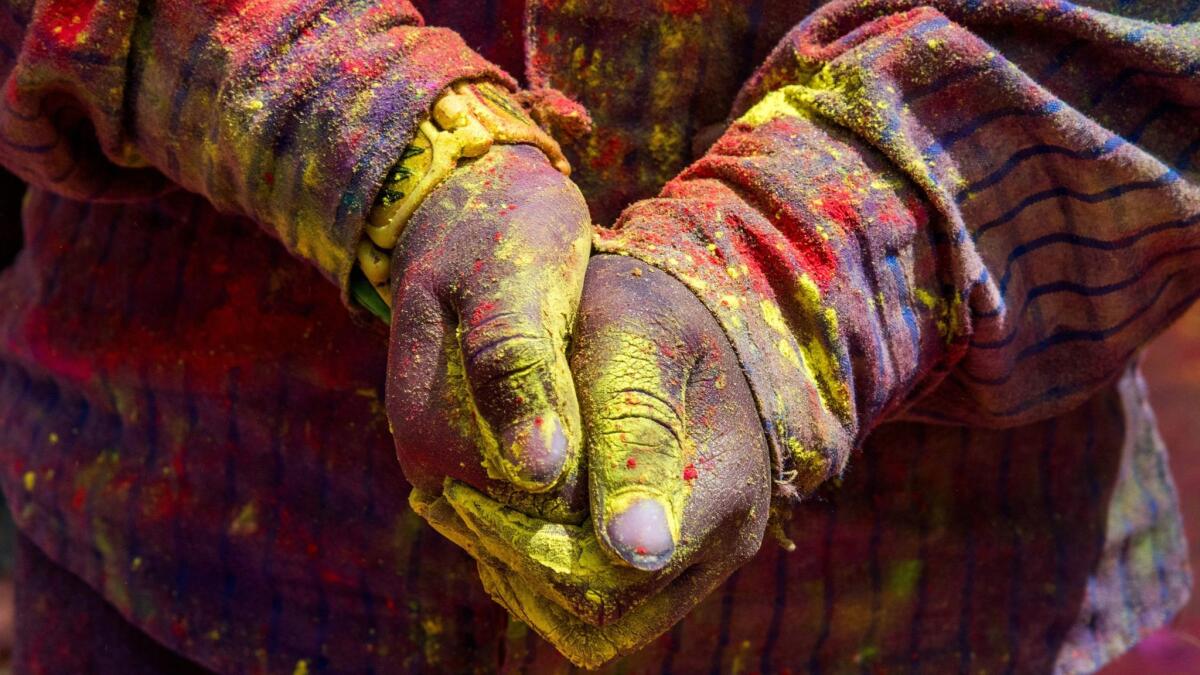
Holi officially begins with the lighting of bonfires on the eve of the day of the full moon preceding the vernal equinox. But it’s the next day that the action really starts.
It works this way: After greeting you with “Happy Holi,” celebrants start digging into trays of brightly colored powdered paint, which they either splatter on you or apply directly to your skin.
You might not expect this at a religious festival, but the holiday is not at all solemn.
People let loose at Holi. They dance in the streets and tell off-color stories. More important, it’s the one time of year when the typical boundaries of caste, sex and age are forgotten.
And nothing beats paint for erasing the barriers that separate a divided society. Everyone starts to blend in once covered in the powdered paint known as gulaal.
Curiously — or coincidentally — that was the name of the haveli-inspired hotel in which we were staying. The Gulaal’s owner, Virendra Singh, had invited us to celebrate with him.
It was only 8 a.m. but the excitement on the streets was palpable as Singh, who has worked as a tour guide, recounted the most common legend of Holi:
“In the scriptures,” Singh explained, “there was a king called Hiranyakashipu, whose ego made him declare, ‘There is no god. I am the god.’ And he started committing atrocities on his public.
“But the king’s son, Prahlad, followed a religious path and began rebelling against his father.
“This disturbed the king so he told his sister, Holika, who’d received a boon [a protective blessing] that she would not burn, to sit in a fire while tricking the prince to get on her lap.”
But “a miracle happened that she burned but not the prince,” signifying the triumph of good over evil.
Hence the bonfires, whose ashes celebrants traditionally applied to their foreheads. This eventually morphed into colored powders, which also represent the bright hues of spring.
By now I found myself focusing more on Singh’s evolving multi-colored visage. He, on the other hand, paid little attention to the newfound colors of his jeans and golf shirt.
“It’s all meant to tell people to be more conscious and kill your own inner Hiranyakashipu, or negative energies, and to be pure and positive,” he said.
With that the tale ended. Singh took us to the lobby, where we piled into a van and started going from place to place, dancing and drinking beer in a Holi version of hotel hopping. During a restroom break I noticed that the paints had transformed my face; I was unrecognizable.
Eventually Singh took us to a friend’s hotel where he brought us a lunch of — what else? — fettuccine Alfredo. Soon it was time to move on to the last venue, but the van was gone and there was only one option — riding on the back of someone’s motorbike.
“There’s no way I’m getting onto that motorcycle,” I said, but minutes later I was cruising down the chaotic streets. The peer pressure had gotten to me.
Those few minutes riding on the back of a motorbike through the hot, dusty streets shifted my perspective from tourist/observer to participant.
If you go
THE BEST WAY TO JAISALMER, INDIA
From LAX, Turkish, Emirates, British, Etihad and China Southern offer connecting service (change of planes) to Jodhpur, India. Restricted round-trip fares from $1,226, including taxes and fees. Jaisalmer is about 140 miles from the Jodhpur Airport.
TELEPHONES
To call the numbers below from the U.S., dial 011 (the international dialing code), 91 (country code for India) and the local number.
TRANSPORTATION
For information on car services, contact Mona Kapoor at Indian Vistas, 124-4255066, mona@indianvistas.com
WHERE TO STAY
The Gulaal, Bera Road, Jaisalmer; 2992-251450. About $115 per night for a luxury suite. An architectural gem with a photo-worthy inner courtyard, spa and roof top restaurant with amazing views. Within walking distance of the Jaisalmer Fort.
1st Gate Home-Fusion, Dhibba Para, Jaisalmer; 2992-254462. $100 per night for a deluxe double room. Gay-friendly boutique hotel features an open-air restaurant (serving Italian-Indian food) with iconic views. It’s also a good starting point for exploring the city.
WHERE TO EAT
Saffron Restaurant, Gandhi Chowk, Jaislamer; 2992-252100 . Multi-ethnic cuisine with Indian, Mughlai, Chinese and Italian options. Great views of the royal palace and live music.
Free Tibet, Fort Road, Jaisalmer; 97820-94554. This restaurant inside the fort offers cozy seating and great views. Tibetan specialties such as chicken thukpa (broth with noodles).
TO LEARN MORE
More to Read
Sign up for The Wild
We’ll help you find the best places to hike, bike and run, as well as the perfect silent spots for meditation and yoga.
You may occasionally receive promotional content from the Los Angeles Times.

